One of the very first combat actions of the German invasion of Poland in 1939 was the attack on the installations at Westerplatte near Danzig/Gdansk. Notable for the inclusoon of the Battleship Schleswig Holstein, it is a battle often mentioned in history books but rarely gamed.
That exclusion was rectified by Russell this week, with yet another game in the Postcard series, converted to Powerpoint.
Tim and Simon got the Poles, while John and I were cast as the wicked Germans. An excuse to break out some hats (I do actually have a Polish hat, but I was on the wrong side for that).
The map is a beautiful scan of the terrain, divided up into areas. The +1/+2 are defensive bonuses applied to the Polish units (only). This is just an example setup with the Schleswig Holstein in the channel area Wb.
The Polish units are platoons or batteries, they have three infantry platoons, an 81mm mortar battery, a 50mm AT battery and a 75mm Field gun battery. The 75s are the unit able to engage the battleship. The infantry and mortars can all take two hits, the artillery just one. Most of the Polish units have a combat strength of 2, 1 when reduced.
For the actual game, the Poles went with a defence in depth. A platoon each in E and F, then the guns G and I, with another platoon and the mortars in H. All units can fire two zones (I guess the infantry have attached MGs and mortars) at a range penalty.
The Germans have a ton of stuff, six infantry companies, an engineer platoon, plus offboard artillery, air support and the battleship. Most of the German units have a combat strength of 3, and can take two hits, the BB has a strength of 4. They don't get any defensive benefits for terrain though, which makes them vulnerable to fire.
It is an activation driven game, each activation lets one unit move or fire, and picture cards allow a unit to rally a hit off OR activate a whole area. The number of activations is driven by a normal deck of cards, black cards are German, Red are Polish, and the number of activations is half the pip score of the card. Keep drawing cards for each side until a joker is drawn and the turn ends.
In the situation above, the Germans have moved on four rifle companies. The Luftwaffe arrived early (once per turn) and opted for repeated bombardment on the port area which gives a combat bonus. The battleship them managed to reduce the defenders by one step.
Combat is resolved by drawing cards from the same deck as the activations (card value =< modified fire value) so if you are doing a lot of things, you really burn through those cards. This means the game goes much faster than the Siege of Rhodes game,
German fire has managed to reduce another Polish platoon, and the Poles have evacuated the docks. With the onus of moving on the Germans, the Poles have a lot more activations to spend on firing, so one of the German companies has been hit, and in a great insult, so has the Schleswig Holstein!
The Germans start with 9VP, they win if at the end of the game there are no Polish units remaining and they have at least 1VP. They lose 1VP per turn, and 1VP per unit destroyed, so the Germans have to be really careful about losses, and spend some activations to recover damaged units, assuming they get the right cards.
Things are looking up a bit for the Germans. They've taken the port and destroyed one of the damaged Polish infantry before it could recover. The damaged battleship has withdrawn out of effective range.
The Poles are back on their +2 cover defensive line now.
The Germans manage to destroy another weakened Polish infantry, but not before taking another hit. The dock is unfortunately in easy range of the entire Polish defence force and quite vulnerable. More fresh German forces have come on to relieve the damaged ones.
The deck is finally exhausted and the turn ends. It took a while as we had a number of discussions about rule interpretations, always an issue with very short games rules, but reached a consensus in the end. Hopefully we will make faster progress tomorrow.
We finished ten minutes early, and a chance for Tim to show off some of his SA Militia, being specially painted for a 54mm figures game of the same battle, which also includes a load of German marine infantry and a very big old rusty battleship.
The next evening continued with the Germans banging their head against the Polish defences. The Poles were able to use their activations to shoot like crazy, while we had to use them to manouvre as well. The toll of damaged German units rose, each worth 1 VP to the Poles, and we had to move them out of the way to avoid their outright destruction.
We finally managed to get force and fire superiority (even bringing the Schleswig Holstein back into action having knocked out the shore battery), and the Poles began to look to their rear areas to put some room between them and us.
The remaining Polish units were both reduced, although annoyingly they would sometimes rally back to full strength, and we had to keep grinding forwards.
A hail of Polish defensive fire reduced two more of our units, but the survivors stuck it out and we finally destroyed the last Polish unit just before time ran out. The time taken and our heavy losses meant we scraped to victory with a measly 1 Victory Point!
What a clever game, very impressive. There are a whole bunch of these postcard games available for the princely sum of £1.50 from here: https://www.boardgameguru.co.uk/pocket-battle-game-1-stand-at-mortain-127833-p.asp











No comments:
Post a Comment